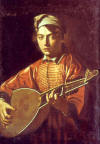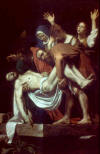|

Still Life: A Basket of
Fruit

The Sick Musician - The Lute
Player

Shield with the Gorgon's
Head
***** Insert: the
Conversion of Saul ****
"
Caravaggio painted Conversion of Saint Paul for the Cerasi
chapel in the Roman church of Santa Maria del Popolo.
It illustrates the conversion fo the pharisee Saul to
Christianity, when he became the disciple Paul. The
saint-to-be appears amid his conversion, flat on his back
with his arms thrown up. In the background an old
hostler [horse-groom] seems preoccupied with taking care of
the horse. At first inspection, little here suggests
the momentous significance of the spiritual event taking
place. The painting's viewers seem to be witnessing a mere
stable accident, not a man overcome by a great miracle.
Although Caravaggio departed from traditional depictions of
such religious scenes, the eloquence and humanity with which
he imbued his paintings impressed many. As a result,
Caravaggio found numerous sympathetic patrons both within
the Roman Catholic Church and from secular realms."
- Gardner's
Art Through The Ages,
11th edition, Vol. II, p. 732

Presentation of the Head of
John the Baptist
***** insert: The Calling of
St. Matthew *****
"A
piercing ray of light illuminating a world of darkness and
bearing a spiritual message is also a central feature of one
of Caravaggio's early masterpieces, Calling of Saint
Matthew. It is one of two large canvases honoring
Saint Matthew the artist painted for the side walls of the
Contarelli chapel in San Luigi dei Francesi in Rome.
The commonplace setting is typical of Caravaggio - a bland
street scene with a plain building wall serving as a
backdrop. Into this mundane environment, cloaked in
mysterious shadow and almost unseen, Christ, identifiable
initially only by his indistinct halo, enters from the
right. With a commanding gesture that recalls that of
the Lord in Michelangelo's Creation of Adam on the Sistine
Chapel ceiling, he summons Levi, the Roman tax collector, to
a higher calling. The astonished tax collector, whose
face is highlighted for viewers by the beam of light
emanating from an unspecified source above Christ's head and
outside the picture, points to himself in disbelief.
Although Christ's extended arm is reminiscent of the Lord in
Creation of Adam, the position of Christ's hand and wrist is
similar to that of Adam. This reference is highly
appropriate - theologically, Christ is the second Adam.
While Adam was responsible for the Fall of Man, Christ is
responsible for human redemption. The conversion of
Levi (who became Matthew) brought his salvation."
- Gardner's
Art Through The Ages,
11th edition, Vol. II, p. 734

Descent from the Cross - The
Entombment of Christ
"In
1603, Caravaggio produced a large-scale painting,
Entombment, for the Chapel of Pietro Vittrice at Santa Maria
in Vallicella in Rome. This work includes all the
hallmarks of Caravaggio's distinctive style: the plebian
figure types (particularly visible in the scruffy, worn face
of Nicodemus - a Pharisee who Christ taught - who holds
Christ's legs in the foreground), the stark use of darks and
lights, and the invitation for viewers to participate in the
scene. As in Conversion of Saint Paul, the
action takes place here in the foreground. The artist
positioned the figures on a stone slab whose corner appears
to extend into the viewer's space. This suggests that
Christ's body will be laid directly in front of viewers."
- Gardner's
Art Through The Ages,
11th edition, Vol. II, p. 734


Two Renditions of the Supper
at Emmaus
"Caravaggio's use of light is certainly dramatic. The
stark contrast of light and dark was a feature of
Caravaggio's style that first shocked and then fascinated
his contemporaries. Caravaggio's use of dark settings
enveloping their occupants, which profoundly influenced
European art, has been called tenebrism, from the
Italian word tenebroso, or "shadowy" manner.
Although tenebrism was widespread in seventeenth-century
art, it made its most emphatic appearance in the art of
Spain and of the Netherlands. In Caravaggio's work,
tenebrism also contributed mightily to the essential meaning
of his pictures."
- Gardner's
Art Through The Ages,
11th edition, Vol. II, pp. 733 - 734
*****insert: David and
Goliath *****
|